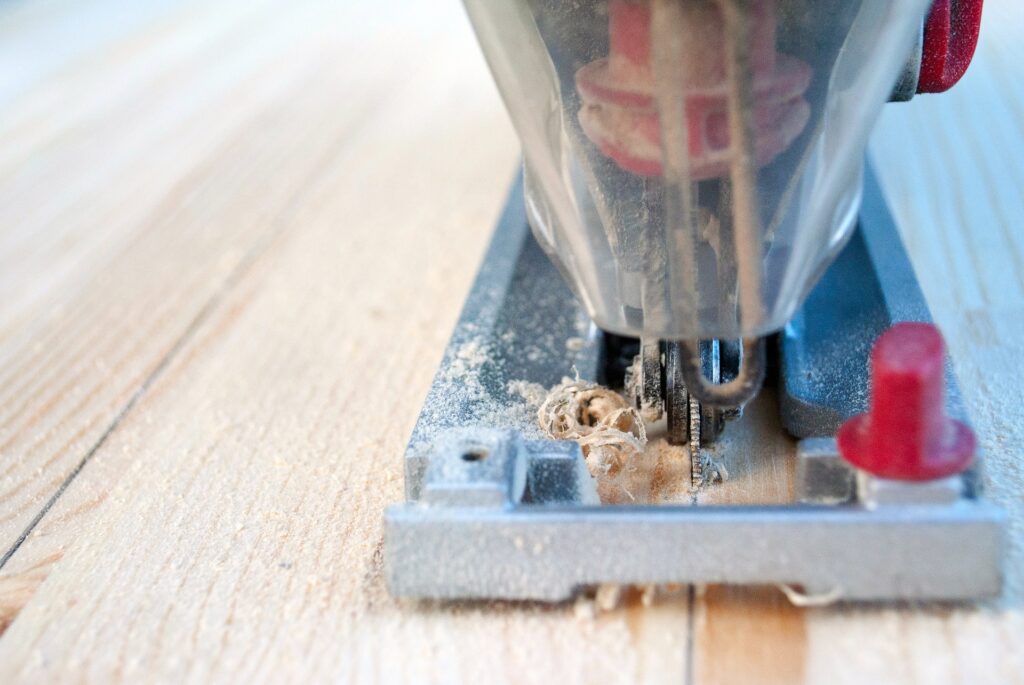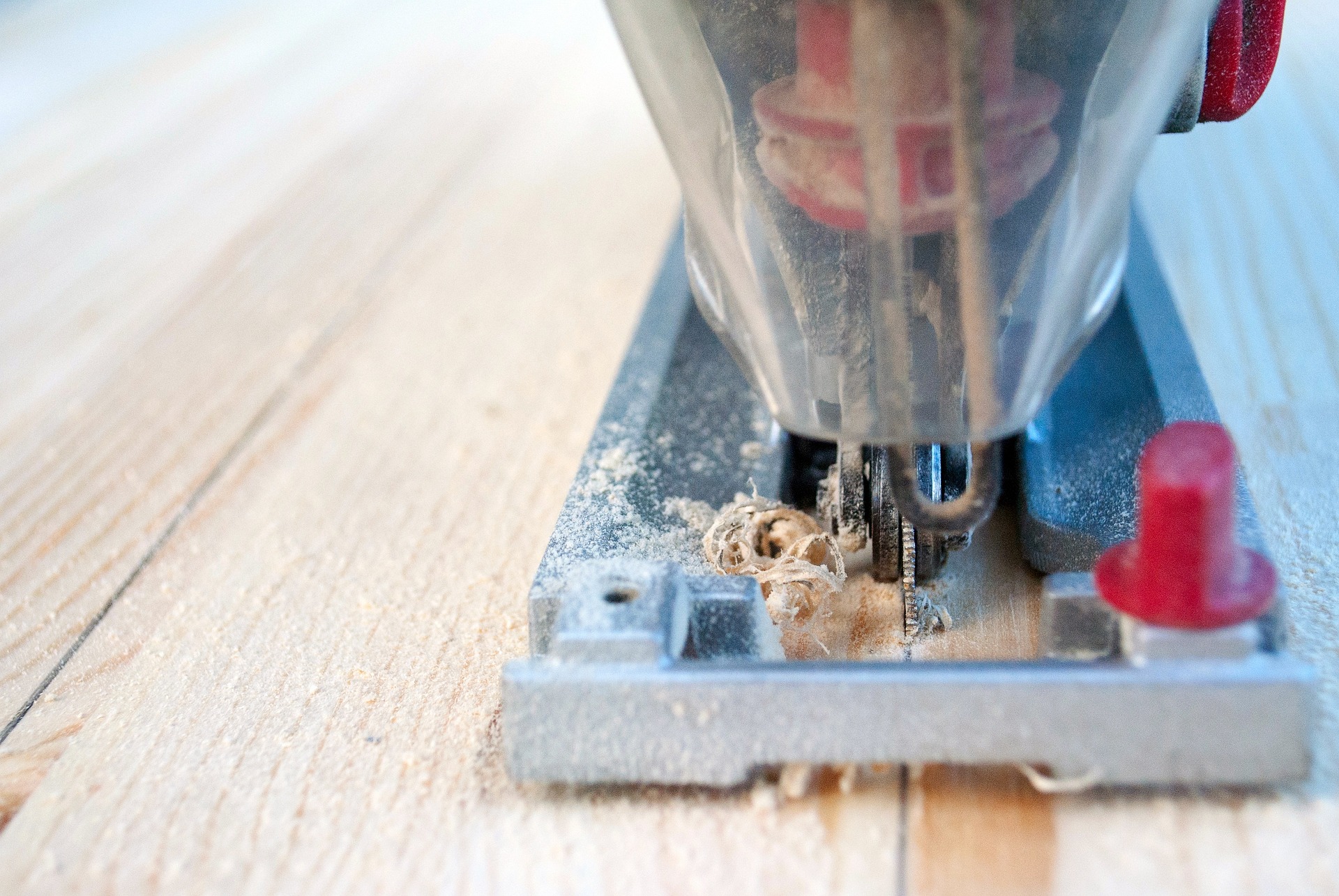You must know your choices if you want to pick out the right saw for every occasion! So, let’s explore the difference between a saber saw and a jigsaw.
Contents
Power source
Understanding the power source is crucial when choosing the right tool for your woodworking or DIY projects. Saber saws and jigsaws can be corded or cordless, which can significantly impact your work. Corded saws provide consistent power without battery recharging, making them suitable for prolonged tasks.
On the other hand, cordless models offer greater mobility and versatility but require periodic recharging. The decision between corded and cordless largely depends on your specific needs. A corded saw might be your best bet if you can access a power source and need sustained performance. Conversely, a cordless version could be more practical if you prioritize maneuverability and convenience.

Blade type and compatibility
When delving into the world of saws, it’s essential to grasp the nuances of blade type and compatibility. Blades are the heartbeat of any cutting tool, and saber saws and jigsaws are no exception. These saws accommodate various blade types designed for specific materials and cutting tasks. Understanding the difference between a saber saw and a jigsaw blade for the job can greatly impact your woodworking or DIY project.
With their straight reciprocating motion, Saber saws often use blades optimized for straight-line cuts through materials like wood, metal, or plastic. With their orbital action, jigsaws excel at intricate curved and plunge cuts, requiring blades with fine teeth and more flexibility. Knowing these distinctions enables you to choose the appropriate blade for your project, ensuring cleaner cuts, smoother operations, and greater project success.
Cutting depth and precision
When using saws, understanding cutting depth and precision is paramount for achieving your desired results. Saber saws and jigsaws offer varying cutting depths, each suited to specific tasks. With their linear motion, Saber saws can handle deeper cuts, making them ideal for thicker materials like lumber or pipes. With their orbital action, jigsaws are more precise for intricate curved cuts and can be adjusted for shallower cuts in thinner materials. This difference ensures you can choose the right tool for your project, avoiding the frustration of making it perform beyond its capabilities.
Precision is equally vital, as it impacts the quality of your cuts. Thanks to their maneuverability and orbital action, jigsaws excel in intricate and detailed work, while saber saws are better suited for straight-line cuts where precision is less critical.
Cutting speed and vibration
Cutting speed and vibration are essential when deciding between a saber saw and a jigsaw. Saber saws boast impressive cutting speeds due to their back-and-forth motion, making them efficient for slicing through various materials. However, this speed can increase vibration, affecting cutting precision and user comfort. Conversely, jigsaws feature an orbital action that minimizes vibration, enhancing control and suitability for intricate, detailed work. In contrast, jigsaws may have slightly slower cutting speeds than saber saws.
However, their reduced vibration creates cleaner, smoother cuts, especially in delicate materials like plywood or plastics. The choice between cutting speed and vibration depends on your project’s requirements, with saber saws excelling in quick, rough cuts and jigsaws providing superior results for precision work with reduced vibration, ensuring a successful woodworking or DIY project.
Maneuverability and ergonomics
Maneuverability and ergonomics are vital in choosing between saber saws and jigsaws. Although ergonomic ergonomics vary, Saber saws, often compact and lightweight, offer excellent maneuverability for navigating tight spaces. On the other hand, jigsaws prioritize ergonomics, providing comfortable handles and reduced vibration, making them ideal for precision tasks. Their ergonomic design ensures user comfort, even during extended projects. Moreover, due to their smaller size, with a trusty tool bag, you’ll be fine!
Noise and dust control
Saber saws, known for their straight reciprocating motion, tend to produce higher noise levels during operation. Managing this noise can be crucial, especially in indoor or sensitive environments. Additionally, dust generated during cutting can be significant, requiring proper ventilation and respiratory protection. On the other hand, jigsaws, with their orbital action, generally produce less noise and dust. Their design minimizes vibration, resulting in a quieter and cleaner cutting experience. That is particularly advantageous when working in shared spaces or when avoiding excessive cleanup is essential. However, regardless of the tool chosen, using appropriate personal protective equipment, such as ear protection and dust masks, is advisable to ensure safety and comfort during your woodworking or DIY project.
Price range and affordability
Price range and affordability are significant factors when choosing between saber saws and jigsaws for your woodworking or DIY projects. Saber saws, often available at a lower cost, provide an economical option, making them suitable for budget-conscious individuals or occasional users. Conversely, jigsaws can come at a slightly higher price point due to their advanced features and versatility. However, this higher cost may be justified for those seeking a versatile, precision-oriented tool for frequent or professional use. Considering the long-term value rather than just the upfront cost is essential.
Investing in a higher-priced jigsaw can yield better performance and durability, potentially saving money on replacements and repairs. Ultimately, the decision hinges on your budget and how often you plan to use the tool.
Maintenance and longevity
Maintenance and longevity are pivotal considerations when choosing between saber saws and jigsaws. Saber saws, known for their simplicity, often require minimal maintenance, primarily blade changes, and occasional cleaning. Their durability makes them a reliable choice for various projects, making them suitable for those seeking a tool that can withstand extended use without frequent upkeep. In contrast, with their more intricate design, jigsaws may need more frequent maintenance, including blade adjustments and periodic lubrication. However, this attention to detail can prolong their lifespan, making them a wise investment for those prioritizing long-term use and performance. When deciding between the two, weighing your maintenance capabilities and willingness against your project needs is crucial.
A saber saw’s low maintenance requirements may be preferable for those with limited time or expertise, while jigsaws offer longevity for those willing to invest in upkeep.
Storage and portability
Storage and portability considerations are essential when choosing between saber saws and jigsaws. Saber saws, often compact and lightweight, are easier to store and transport, making them a convenient choice for those with limited workshop space or needing to carry tools to different job sites. Their simplicity contributes to hassle-free packing and relocation. In contrast, jigsaws, while versatile, can be bulkier and less portable due to their additional features and components. They may require more space and careful handling during transport to prevent damage. So, when you are packing power tools for a move and working to prepare your tools for relocation, take note of these differences! Overall, for those with a dedicated workshop, a jigsaw’s versatility may outweigh its portability concerns. However, if you require a tool that can easily accompany you on the go, a compact and portable saber saw could be the more practical choice.
Safety features and precautions
Safety features and precautions are paramount when working with saber saws and jigsaws. Saber saws typically include safety features like blade guards and trigger locks, which help minimize the risk of accidents. However, users must exercise caution when operating these tools, wear appropriate protective gear like safety goggles and gloves, and ensure the workpiece is securely clamped. On the other hand, jigsaws often come with more advanced safety features, such as blade covers and anti-kickback mechanisms. These additions enhance user protection, especially during intricate cuts. Still, following safety guidelines is essential. Remember to disconnect the tool from the power source when changing blades, and never bypass safety features. Whether you choose a saber saw or a jigsaw, it’s crucial to prioritize safety precautions to avoid accidents and injuries in your woodworking projects. So, together with some good woodworking clamps, you’ll be perfectly safe!
Conclusion on the difference between a saber saw and a jigsaw
With everything we covered on the difference between a saber saw and a jigsaw, you can make your selection! Just make sure to consider every difference between the two truly, and you’ll be fine.

